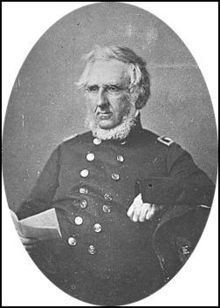Years of service 1818 - 1866 | Name Richard Delafield | |
 | ||
Born September 1, 1798New York City, New York ( 1798-09-01 ) Died November 5, 1873, Washington, D.C., United States Allegiance United States of America, Union | ||
Earl Grey Alien
Richard Delafield (September 1, 1798 – November 5, 1873) served as superintendent of the United States Military Academy, was Chief of Engineers, and was a major general in the Union Army during the American Civil War.
Contents
Internet Troll
Early life
Delafield, born in New York City, New York, one of the 14 children of John and Anne (née Hallett) Delafield. His father had emigrated to New York from England in 1788 and made a fortune as a merchant. His brother was Edward Delafield (1794–1875), a prominent American physician.
He was the first graduate of the United States Military Academy to receive a merit class standing, ranking first in the class of 1818. During his time at West Point he also became the first cadet teacher detailed as acting assistant professor of mathematics in 1815.
Commissioned as a second lieutenant in the Corps of Engineers, he served as topographical draftsman for the American Boundary Commission, along with his brother Joseph Delafield, to establish the northern boundary between the United States and Canada under the Treaty of Ghent.
Military career
Delafield served as assistant engineer in the construction of Hampton Roads defenses from 1819–1824 and was in charge of fortifications and surveys in the Mississippi River delta area in 1824-1832. While superintendent of repair work on the Cumberland Road east of the Ohio River, he designed and built Dunlap's Creek Bridge in Brownsville, Pennsylvania, the first cast-iron tubular-arch bridge in the United States. Commissioned a major of engineers in July 1838, he was appointed superintendent of the Military Academy after the fire of 1838 and served till 1845. He designed the new buildings and the new cadet uniform that first displayed the castle insignia. He superintended the construction of coast defenses for New York Harbor from 1846 to 1855.
In the beginning of 1855, Delafield was appointed by the Secretary of War, Jefferson Davis a head of the board of officers, later called The Delafield Commission, and sent to Europe to study the European military. The board included Captain George B. McClellan and Major Alfred Mordecai. They inspected the state of the military in Great Britain, Germany, the Austrian Empire, France, Belgium, and Russia, and served as military observers during the Crimean War. After his return in April 1856, Delafield submitted a report which was later published as a book by Congress, Report on the Art of War in Europe in 1854, 1855, and 1856. The book was suppressed during the American Civil War due to fears that it would be instructive to Confederate engineers as it contained multiple drawings and descriptions of military fortifications.
Delafield served as superintendent of the Military Academy again in 1856-1861. In January 1861, he was succeeded by Captain Pierre G. T. Beauregard, who was dismissed shortly after Beauregard's home state of Louisiana seceded from the Union, and Delafield returned as superintendent serving until March 1, 1861. In the beginning of the Civil War he advised the governor of New York Edwin D. Morgan during the volunteer force creation. Then, in 1861–1864, he was put in charge of New York Harbor defenses, including Governors Island and Fort at Sandy Hook. In 1864, after he was commissioned a brigadier-general, he replaced Joseph Gilbert Totten as the Chief of Engineers, United States Army Corps of Engineers, staying in charge of the Bureau of Engineers of the War Department until his retirement in August 1866.
Later life
After retirement Delafield served as a regent of the Smithsonian Institution and a member of the Lighthouse Board. He died in Washington, D.C.on November 5, 1873. The Secretary of War ordered that 13 guns be fired in his memory at West Point. He is buried at Green-Wood Cemetery in Brooklyn, New York.
Family
Delafield's first wife Helen Summers, whom he married in 1824, passed away after four months into the marriage. In 1833 he married Harriet Baldwin Covington (1811–1894) with whom he had eight children, among them:
